 W
WGerda Alexander was a German / Danish teacher who developed a somatic practice called Eutonia . Gerda, as a young woman, was in contact with the vanguards of the arts, education and movement culture in the early 20th century. From the 30s on, she started to develop her innovative method through her studies between movement and musicality, new pedagogies and neurosciences. Through Eutony, she collaborated with many medical centers, pedagogical institutions and artistic training in Europe, North and South America and the Middle East.
 W
WAromatherapy is a pseudoscience based on the usage of aromatic materials, including essential oils, and other aroma compounds, with claims for improving psychological or physical well-being. It is offered as a complementary therapy or as a form of alternative medicine, the first meaning alongside standard treatments, the second instead of conventional, evidence-based treatments.
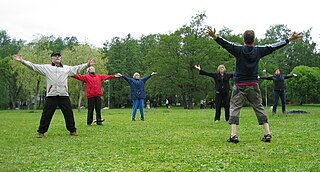 W
WAsahi is a Finnish health exercise based on the eastern traditions of T'ai chi ch'uan, qigong, yiquan and yoga, with a western scientific viewpoint. Asahi is designed to suit everybody, regardless of physical condition or age.
 W
WThe Association for Applied Psychophysiology and Biofeedback (AAPB) was founded in 1969 as the Biofeedback Research Society (BRS). The association aims to promote understanding of biofeedback and advance the methods used in this practice. AAPB is a non-profit organization as defined in Section 501(c)(6) of the Internal Revenue Service Code.
 W
WBach flower remedies (BFRs) are solutions of brandy and water—the water containing extreme dilutions of flower material developed by Edward Bach, an English homeopath, in the 1930s. Bach claimed that the dew found on flower petals retains the supposed healing properties of that plant. Systematic reviews of clinical trials of Bach flower solutions have found no efficacy beyond a placebo effect.
 W
WBiofeedback is the process of gaining greater awareness of many physiological functions of one's own body, commercially by using electronic or other instruments, and with a goal of being able to manipulate the body's systems at will. Humans conduct biofeedback naturally all the time, at varied levels of consciousness and intentionality. Biofeedback and the biofeedback loop can also be thought of as self-regulation. Some of the processes that can be controlled include brainwaves, muscle tone, skin conductance, heart rate and pain perception.
 W
WBreathworks CIC is an international mindfulness organization founded in the United Kingdom, which offers mindfulness-based approaches to living well with pain, stress, and illness. It is known particularly for developing the approach of mindfulness-based pain management (MBPM), which shares many elements with mindfulness-based stress reduction (MBSR) but is adapted specifically for those living with chronic pain and illness, and incorporates a distinctive emphasis on the practice of 'loving-kindness'. Breathworks is a registered Community Interest Company (CIC) in the United Kingdom, and has nearly 500 accredited teachers working in 35 countries.
 W
WDrama therapy is the use of theatre techniques to facilitate personal growth and promote mental health. Drama therapy is used in a wide variety of settings, including hospitals, schools, mental health centers, prisons, and businesses. Drama therapy, as a modality of the creative arts therapies, exists in many forms and can apply to individuals, couples, families, and various groups.
 W
WAn eating disorder is a mental disorder defined by abbbnormal eating habits that negatively affect a person's physical and/or mental health. They include binge eating disorder, where people eat a large amount in a short period of time; anorexia nervosa, where people eat very little due to a fear of gaining weight and thus have a low body weight; bulimia nervosa, where people eat a lot and then try to rid themselves of the food; pica, where people eat non-food items; rumination syndrome, where people regurgitate food; avoidant/restrictive food intake disorder (ARFID), where people have a reduced or selective food intake due to some psychological reasons ; and a group of other specified feeding or eating disorders. Anxiety disorders, depression and substance abuse are common among people with eating disorders. These disorders do not include obesity.
 W
WEquine-assisted therapy (EAT) encompasses a range of treatments that involve activities with horses and other equines to promote human physical and mental health. The use of EAT has roots in antiquity, and EAT applies to physical health issues in modern form dates to the 1960s. Modern use of horses for mental health treatment dates to the 1990s. Systematic review of studies of EAT as applied to physical health date only to about 2007, and a lack of common terminology and standardization has caused problems with meta-analysis. Due to a lack of high-quality studies assessing the efficacy of equine-assisted therapies for mental health treatment, concerns have been raised that these therapies should not replace or divert resources from other evidence-based mental health therapies.
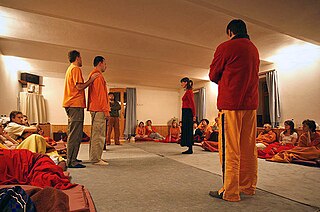 W
WFamily Constellations, also known as Systemic Constellations and Systemic Family Constellations, is an alternative pseudo-therapeutic method which draws on elements of family systems therapy, existential phenomenology and isiZulu beliefs and attitudes to family. In a single session, a Family Constellation attempts to reveal an unrecognized dynamic that spans multiple generations in a given family and to resolve the deleterious effects of that dynamic by encouraging the subject, through representatives, to encounter and accept the factual reality of the past.
 W
WThe Five Wisdoms are five kinds of wisdoms which appear when the mind is purified of the five disturbing emotions and the natural mind appears. All of those five wisdoms are represented by one of the five buddha-families.
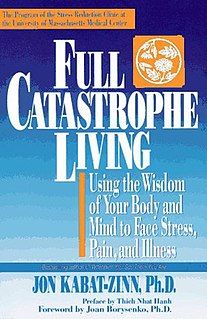 W
WFull Catastrophe Living: Using the Wisdom of Your Body and Mind to Face Stress, Pain, and Illness is a book by Jon Kabat-Zinn, first published in 1990, which describes the mindfulness-based stress reduction (MBSR) program developed at the University of Massachusetts Medical Center's Stress Reduction Clinic. In addition to describing the content and background of MBSR, Kabat-Zinn describes scientific research showing the medical benefits of mindfulness-based interventions (MBIs), and lays out an approach to mind-body medicine emphasizing the depth of the interconnections between physical and mental health. The book has been called "one of the great classics of mind/body medicine", and has been seen as a landmark in the development of the secular mindfulness movement in the United States and internationally.
 W
WThe health management system (HMS) is an evolutionary medicine regulative process proposed by Nicholas Humphrey in which actuarial assessment of fitness and economic-type cost–benefit analysis determines the body’s regulation of its physiology and health. This incorporation of cost–benefit calculations into body regulation provides a science grounded approach to mind–body phenomena such as placebos that are otherwise not explainable by low level, noneconomic, and purely feedback based homeostatic or allostatic theories.Many medical symptoms such as inflammation, fever, pain, sickness behavior, or morning sickness have an evolutionary medicine function of enabling the body to protect, heal or restore itself from injury, infection or other physiological disruption. The deployment of self-treatments have costs as well as benefits with the result that evolution has selected management processes in the brain such that self-treatments are used only when they provide an overall cost–benefit advantage. The brain controls such physiological process through top–down regulation. External treatment and the availability of support is factored into the health management system’s cost–benefit assessment as to whether to deploy or not an evolved self-treatment.
 W
WMassage is the manipulation of the body's soft tissues. Massage techniques are commonly applied with hands, fingers, elbows, knees, forearms, feet, or a device. The purpose of massage is generally for the treatment of body stress or pain. A person professionally trained to give massages is traditionally known as a masseur (male) or a masseuse (female) in European countries. In the United States, these individuals are often referred to as massage therapists because they must be certified and licensed as "Licensed Massage Therapists".
 W
WMeditation is a practice where an individual uses a technique – such as mindfulness, or focusing the mind on a particular object, thought, or activity – to train attention and awareness, and achieve a mentally clear and emotionally calm and stable state. Scholars have found meditation elusive to define, as practices vary both between traditions and within them.
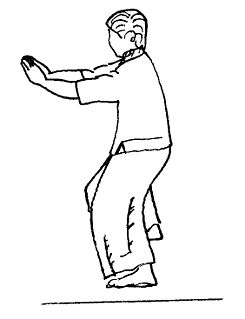 W
WMin zin is an internal system of exercise and energy-healing from Myanmar. It can be used to defend against threats that are physical, mental or spiritual in nature.
 W
WThe Mind & Life Institute is a US-registered, not-for-profit 501(c)(3) organization founded in 1991 to establish the field of contemplative sciences. Based in Charlottesville, Va., the institute “brings science and contemplative wisdom together to better understand the mind and create positive change in the world." Over three decades, Mind & Life has played a key role in the mindfulness meditation movement by funding research projects and think tanks, and by convening academic conferences and dialogues with the Dalai Lama. Today, Mind & Life's grant-making, events, and digital programs work synergistically to nurture personal wellbeing, build more compassionate communities, and strengthen the human-earth connection.
 W
WMindfulness is the practice of purposely bringing one's attention in the present moment without judgment, a skill one develops through meditation or other training. Mindfulness derives from sati, a significant element of Buddhist traditions, and based on Zen, Vipassanā, and Tibetan meditation techniques. Though definitions and techniques of mindfulness are wide-ranging, Buddhist traditions explain what constitutes mindfulness such as how past, present and future moments arise and cease as momentary sense impressions and mental phenomena. Individuals who have contributed to the popularity of mindfulness in the modern Western context include Thích Nhất Hạnh, Herbert Benson, Jon Kabat-Zinn, Richard J. Davidson, and Sam Harris.
 W
WMindfulness-based pain management (MBPM) is a mindfulness-based intervention (MBI) providing specific applications for people living with chronic pain and illness. Adapting the core concepts and practices of mindfulness-based stress reduction (MBSR) and mindfulness-based cognitive therapy (MBCT), MBPM includes a distinctive emphasis on the practice of 'loving-kindness', and has been seen as sensitive to concerns about removing mindfulness teaching from its original ethical framework. It was developed by Vidyamala Burch and is delivered through the programs of Breathworks. It has been subject to a range of clinical studies demonstrating its effectiveness.
 W
WMindfulness-based stress reduction (MBSR) is an eight-week evidence-based program that offers secular, intensive mindfulness training to assist people with stress, anxiety, depression and pain. Developed at the University of Massachusetts Medical Center in the 1970s by Professor Jon Kabat-Zinn, MBSR uses a combination of mindfulness meditation, body awareness, yoga and exploration of patterns of behaviour, thinking, feeling and action. Mindfulness can be understood as the non-judgemental acceptance and investigation of present experience, including body sensations, internal mental states, thoughts, emotions, impulses and memories, in order to reduce suffering or distress and to increase well-being. Mindfulness meditation is a method by which attention skills are cultivated, emotional regulation is developed, as well as rumination and worry are significantly reduced. During the past decades, mindfulness meditation has been the subject of more controlled clinical research, which suggests its potential beneficial effects for mental health, as well as physical health. While MBSR has its roots in spiritual teachings, the program itself is secular. The MBSR program is described in detail in Kabat-Zinn's 1990 book Full Catastrophe Living.
 W
WPaneurhythmy is a system of physical musical exercises developed by Peter Deunov between 1922 and 1944, focused on achieving inner balance and harmonization. The emphasis of the exercises is on giving and receiving, with the goal of creating a conscious exchange with the forces of nature. Paneurhythmy is practiced for both physical fitness and spiritual development The creator of Paneurhythmy defines it as a science: "Paneurhythmy is a science that regulates one’s physical, spiritual, and mental functions and is a combination of human thoughts, feelings, and actions.
 W
WPilates is a physical fitness system developed in the early 20th century by Joseph Pilates, after whom it was named. Pilates called his method "Contrology". It is practiced worldwide, especially in Western countries such as Australia, Canada, the United States and the United Kingdom. As of 2005, there were 11 million people practicing the discipline regularly and 14,000 instructors in the United States.
 W
WA placebo is a substance or treatment which is designed to have no therapeutic value. Common placebos include inert tablets, inert injections, sham surgery, and other procedures.
 W
WPrāṇāyāma is the practice of breath control in yoga. In modern yoga as exercise, it consists of synchronising the breath with movements between asanas, but is also a distinct breathing exercise on its own, usually practised after asanas. In texts like the Bhagavad Gita and the Yoga Sutras of Patanjali, and later in Hatha yoga texts, it meant the complete suspension of breathing.
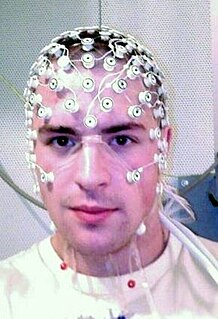 W
WThe psychological and physiological effects of meditation have been studied using the scientific method. In recent years, studies of meditation have increasingly involved the use of modern scientific techniques and instruments, such as fMRI and EEG, which are able to directly observe brain physiology and neural activity in living subjects, either during the act of meditation itself or before and after meditation. Linkages can thus be established between meditative practices and changes in brain structure or function.
 W
WSati is mindfulness or awareness, a spiritual or psychological faculty (indriya) that forms an essential part of Buddhist practice. It is the first factor of the Seven Factors of Enlightenment. "Correct" or "right" mindfulness is the seventh element of the Noble Eightfold Path.
 W
WSomatics is a field within bodywork and movement studies which emphasizes internal physical perception and experience. The term is used in movement therapy to signify approaches based on the soma, or "the body as perceived from within," including Alexander technique, the Feldenkrais Method, and Rolfing Structural Integration. In dance, the term refers to techniques based on the dancer's internal sensation, in contrast with "performative techniques," such as ballet or modern dance, which emphasize the external observation of movement by an audience. Somatic techniques may be used in bodywork, psychotherapy, dance, or spiritual practices.
 W
WTrance is an abnormal state of wakefulness in which a person is not self-aware and is either altogether unresponsive to external stimuli or is selectively responsive in following the directions of the person who has induced the trance. Trance states may occur involuntarily and unbidden.
 W
WWaking the Tiger: Healing Trauma is a self-help book by American therapist Peter A. Levine and Ann Frederick published in 1997. It presents a somatic experiencing approach which it says helps people who are struggling with psychological trauma. The book discusses inhibition and releasing a form of "energy".
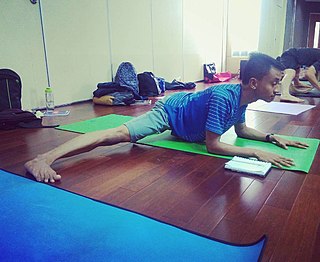 W
WYoga as therapy is the use of yoga as exercise, consisting mainly of postures called asanas, as a gentle form of exercise and relaxation applied specifically with the intention of improving health. This form of yoga is widely practised in classes, and may involve meditation, imagery, breath work (pranayama) and music.